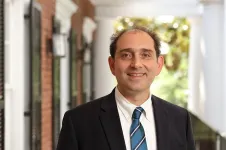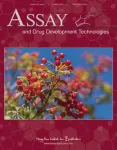(Press-News.org) Long-term, low-dose antiviral treatment reduces the risk for potentially vision-damaging bouts of inflammation and infection, as well as pain, which occur when shingles affects the eye, according to new research presented October 19 at the annual meeting of the American Academy of Ophthalmology (AAO) in Chicago.
Shingles occurs when the varicella-zoster virus, which causes chickenpox in children, lies dormant for decades in nerve cells and then starts multiplying again for reasons unknown. It commonly affects people 50 and older, and adults with impaired immune systems due to disease or treatment. The virus spreads down a nerve pathway to cause a painful blistering rash in the skin area that the nerve wires.
In about 8 percent of the more than 1 million new shingles cases in the United States each year, the virus awakens in the nerve that supplies the forehead and eye, a condition called herpes zoster ophthalmicus, or HZO. Shingles causes keratitis when it affects the cornea, and iritis when inside the eye, with both causing pain, redness, decreased vision, and sometimes glaucoma. Repeated flare-ups are associated with chronic eye disease, scarring, and vision loss.
The new research, part of the eight-year Zoster Eye Disease Study (ZEDS) and presented at the AAO meeting’s Cornea Subspecialty Day, shows that study participants treated for a year with a low dose of the inexpensive and safe antiviral drug valacyclovir (Valtrex) saw a 26 percent reduction in their risk of having new or worsening eye disease (keratitis or iritis) at 18 months. Those treated were significantly less likely than those who got a placebo to have multiple disease flare-ups, with a 30 percent reduction at 12 months and a 28 percent reduction at 18 months.
In addition, participants on valacyclovir were found to have a shorter duration of pain at 18 months and needed significantly less neuropathic pain medication. Reducing the use of such medications (e.g., pregabalin and gabapentin) was a goal of the work because they have limited effectiveness and often cause dizziness, a poor fit for older patients, who are at the greatest risk for debilitating chronic pain after shingles.
“Our results support changes in clinical practice, with suppressive valacyclovir recommended to reduce new, worsening, and repeated episodes of eye disease, as well as need for neuropathic pain medication in HZO patients and in those with shingles-related pain,” said study chair and principal investigator Elisabeth J. Cohen, MD, professor of ophthalmology at NYU Grossman School of Medicine and NYU Langone Health, and vice chair for academic affairs in the department. Dr. Cohen has focused her research on HZO over the 16 years since suffering from it herself in 2008, which damaged her vision and ended her career as a cornea surgeon.
“Current standard treatment is a 7- to 10-day course of an antiviral, including the study drug valacyclovir,” Dr. Cohen added. “We explored longer-term treatment because, while the standard approach has been shown to reduce the chances for chronic eye disease, it still leaves many suffering from it. We propose adding to the standard approach a year of low dose valacyclovir treatment.”
The ZEDS study was funded the National Eye Institute (NEI), part of the National Institutes of Health, and led by NYU Langone. The presentation examined whether long-term antiviral treatment could reduce eye disease and whether the same treatment lessened post-herpetic neuralgia, or PHN, the chronic nerve pain syndrome that often accompanies shingles, especially in patients over age 65.
“Up until now, there has been no proven long-term treatment for new, worsening, or repeated episodes of zoster eye disease,” said ZEDS study co-chair Bennie Hau Jeng, MD, chair of the Department of Ophthalmology at the University of Pennsylvania, who also presented at the Cornea and Eye Banking Forum in Chicago. “The results of this study provide convincing evidence for using long-term, low-dose antiviral treatment to reduce eye disease in HZO and decrease pain from shingles.”
Conducted in 95 medical centers in the USA, Canada, and New Zealand, ZEDS enrolled 527 participants from November 2017 to January 2023 who were randomized to receive, double-masked, either 1,000 mg of valacyclovir daily or a placebo. Patients were required to have functioning immune systems and kidneys, be older than 18, and have had a history of typical HZO rash, and active keratitis or iritis within a year before enrollment.
“While our evidence in support of a new treatment regimen is vital, prevention is even more effective than any treatment,” Dr. Cohen said. “The incidence of shingles is going up in persons in their 50s, and just 12 percent of them have received the highly effective Shingrix vaccine. This vaccine has been recommended since 2018 for all adults 50 and older and, since 2022, for immunocompromised adults 19 and older.”
Other principal study investigators from NYU Langone were Andrea B. Troxel, ScD, director of the Division of Biostatistics within the Department of Population Health, and clinical trialist Judith S. Hochman, MD, the senior associate dean for clinical sciences. ZEDS was funded by NEI grant U10 EY026869 and made possible by the ZEDS network of principal investigators and study participants who volunteered. The research was also made possible through funding from the National Shingles Foundation, and a grant to the NYU Langone Department of Ophthalmology from Research to Prevent Blindness.
END
Long-term low-dose antiviral treatment benefits patients with eye disease and pain from shingles
2024-10-19
ELSE PRESS RELEASES FROM THIS DATE:
Long-term antiviral use is key to ocular shingles treatment
2024-10-19
Taking an antiviral medication for a year may prevent vision damage associated with shingles that affects the eye, according to new research led by faculty from the Perelman School of Medicine at the University of Pennsylvania and the NYU Grossman School of Medicine at NYU Langone Health.
“Up until now, there has been no proven long-term treatment for new, worsening, or repeated episodes of this disease, so the results of this study provide convincing evidence for using long-term, low-dose antiviral treatment,” said Bennie Jeng, MD, chair of Ophthalmology at the Perelman School of Medicine at the University of Pennsylvania ...
American Society of Anesthesiologists honors Mary Dale Peterson, M.D., MSHCA, FACHE, FASA, with its Distinguished Service Award
2024-10-19
PHILADELPHIA — The American Society of Anesthesiologists (ASA) today presented Mary Dale Peterson, M.D., MSHCA, FACHE, FASA, with its 2023 Distinguished Service Award in recognition of her enduring contributions to advancing patient-centered, physician-led health care. Her dedicated service to the specialty and ASA includes her leadership as ASA president during the first year of the COVID-19 pandemic. The award is the highest honor ASA bestows and is presented annually to a member who has transformed the specialty of anesthesiology.
Nationally recognized for her role in guiding health plans and hospitals, Dr. Peterson currently serves ...
Innovation south facility opens in UT Research Park at Cherokee farm
2024-10-18
The University of Tennessee, Knoxville’s Fibers and Composites Manufacturing Facility has a new home and IACMI – The Composites Institute has new headquarters with the dedication of Innovation South.
Innovation South is an 85,000-square-foot multiuse facility in UT’s Research Park at Cherokee Farm, located just off Alcoa Highway across the Tennessee River from the flagship university’s main campus. Developed and owned by Partners Development, the building includes a 40,000-square-foot ...
Photonic computing harnesses electromagnetic waves
2024-10-18
In the fields of physics, mathematics, and engineering, partial differential equations (PDEs) are essential for modeling various phenomena, from heat diffusion to particle motion and wave propagation. While some PDEs can be solved analytically, many require numerical methods, which can be time-consuming and computationally intensive. To address these challenges, scientists have been exploring alternative computing paradigms, including photonic computing.
Photonic computing leverages light–matter interactions to perform ...
Loss of ‘nitrogen fixers’ threatens biodiversity, ecosystems
2024-10-18
STARKVILLE, Miss.—Mississippi State University is part of a European-American collaboration studying how human activities, like fertilizer use and polluting, are impacting nitrogen-fixing plants which are crucial for maintaining healthy ecosystems by adding nitrogen to the soil.
MSU Assistant Professor Ryan A. Folk of the Department of Biological Sciences co-authored a study published today [Oct. 18] in Science Advances, showing that increased nitrogen deposition from human activity is reducing the diversity and evolutionary distinctiveness of nitrogen-fixing plants. Lead author Pablo Moreno García, ...
UH Energy Transition Institute launches radio show and online webinars focused on addressing grand challenges in energy
2024-10-18
HOUSTON, Oct. 18, 2024 –The University of Houston Energy Transition Institute is launching two educational series focused on exploring the unfolding energy transition and addressing the grand challenges in energy.
Starting October 21, "Driving the Energy Transition," will air on Houston Public Media’s KUHF News 88.7 with new episodes launching every two weeks on Mondays. The following day, October 22, the Energy Transition Webinar series will begin, running biweekly on ...
UVA professor tackles graph mining challenges with new algorithm
2024-10-18
University of Virginia School of Engineering and Applied Science professor Nikolaos Sidiropoulos has introduced a breakthrough in graph mining with the development of a new computational algorithm.
Graph mining, a method of analyzing networks like social media connections or biological systems, helps researchers discover meaningful patterns in how different elements interact. The new algorithm addresses the long-standing challenge of finding tightly connected clusters, known as triangle-dense subgraphs, within large networks — a problem that is critical in fields such as fraud detection, computational biology and data ...
Announcing the new editor-in-chief of ASSAY and Drug Development Technologies
2024-10-18
New Rochelle, NY, October 17, 2025—Mary Ann Liebert, Inc., is pleased that Wai Hong (Kevin) Lo, PhD, has been appointed the new Editor-in-Chief of the journal ASSAY and Drug Development Technologies. Dr. Lo is replacing Bruce Melancon, PhD as Editor-in-Chief.
ASSAY and Drug Development Technologies provides access to novel techniques and robust tools that enable critical advances in early-stage screening. This research published in the Journal leads to important therapeutics and platforms for drug discovery and development. This peer-reviewed journal features original papers application-oriented technology reviews, topical issues on ...
Finding could help turn trees into affordable, greener industrial chemicals
2024-10-18
EMBARGOED FOR RELEASE UNTIL 2 P.M. EDT ON FRIDAY, OCT. 18
Trees are the most abundant natural resource living on Earth’s land masses, and North Carolina State University scientists and engineers are making headway in finding ways to use them as sustainable, environmentally benign alternatives to producing industrial chemicals from petroleum.
Lignin, a polymer that makes trees rigid and resistant to degradation, has proven problematic. Now those NC State researchers know why: They’ve identified the ...
UTA to host discussion on Texas energy needs
2024-10-18
The University of Texas at Arlington will host GridNEXT DFW 2024: Meeting the Demand, an event dedicated to envisioning the future of energy infrastructure, on Oct. 25 from 9 a.m. to 3 p.m.
The one-day seminar will bring together industry partners, leaders, government officials and private stakeholders across the Texas energy space to discuss growing power needs and how to better support the Texas power grid.
It will be held at UTA’s Rio Grande Ballroom, 300 W. First St. in Arlington. Woody Rickerson, ERCOT senior vice ...






